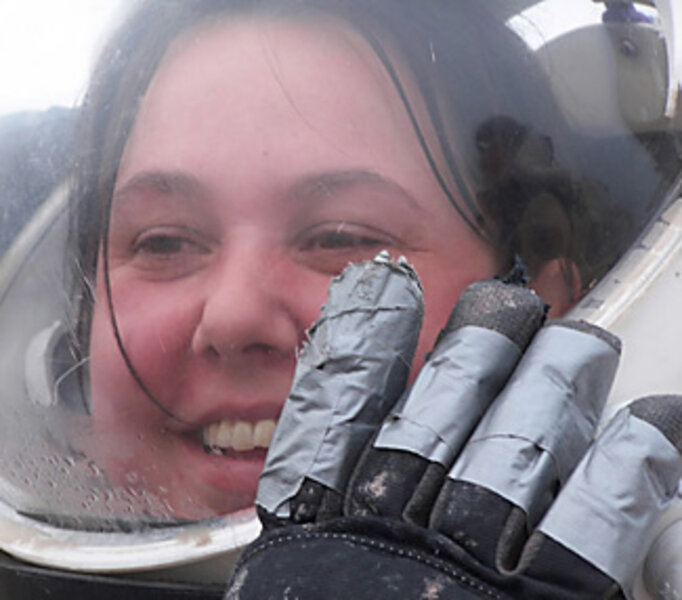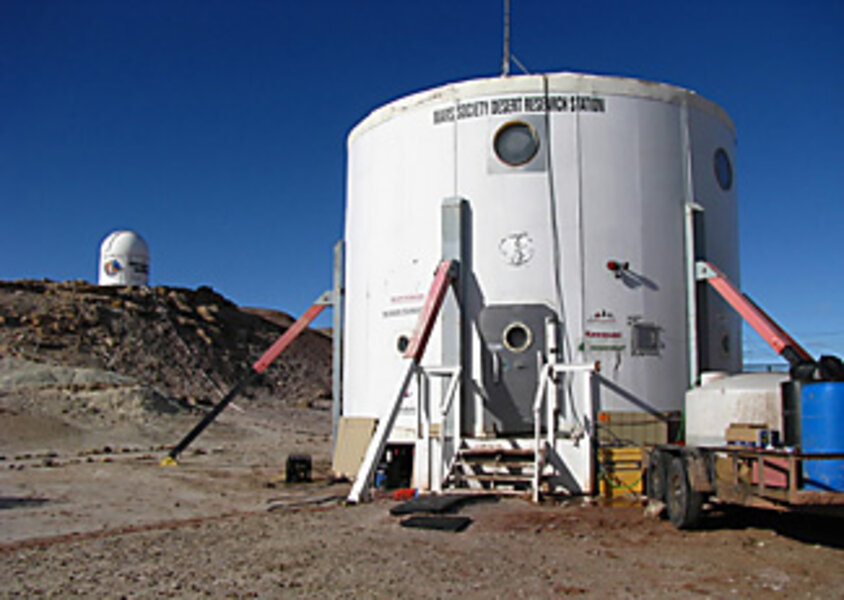A mission to Mars, in Utah
Loading...
Phillip Cunio celebrated his wife's birthday from Mars. He held a card up to his habitat webcam so she could see it online, and fellow crew members baked a cake.
Granted, this "Mars" was the Utah desert, but spending two weeks on a simulated mission to the Red Planet gave him a taste of what it would be like to fulfill his dream. And the freeze-dried flavor didn't dampen his enthusiasm.
Mr. Cunio moved into the Mars Desert Research Station (MDRS), just outside Hanksville, Utah, to test equipment being developed by the Space Logistics Project and other partners at the Massachusetts Institute of Technology in Cambridge, Mass. (http://spacelogistics.mit.edu).
He was part of an eight-person international crew including engineers, a biologist, and a GPS expert all doing their own research. For two weeks, they traded earthly conveniences for scientific progress. They imposed a delay of roughly 20 minutes on e-mails. When they ventured outside their cylindrical two-level habitat, they had to wait in an airlock and don bulky simulated spacesuits – complete with boots, ski gloves, and bulbous helmets.
The Mars Society has been running mock missions since 2002 to promote – and prepare for – sending humans to a frontier that only telescopes and rovers have explored so far. "It's kind of a dress rehearsal," says Robert Zubrin, president and founder of the nonprofit society based in Lakewood, Colo. "We're looking to see what would work on Mars and what wouldn't – what skill mix, what character mix, what set of tools...." The society also operates a research station in Canada's Devon Island in the Arctic.
Mr. Zubrin believes a Mars program could inspire this generation of youths the way the 1960s moon program inspired him. The technology would be ready if the new American president would commit next year, he says: "We could be on Mars before the end of their second term."
During Cunio's mission in February, he tracked supplies in the MIT research team's Smart Small Logistics Container – garbage bags, batteries, latex gloves. Using RFID (radio-frequency identification), the small hexagonal container can communicate via a Web-based server when items have been removed and replaced.
Fellow MIT graduate student Arthur Guest did his two-week stint at the research station first, to set up and test the container, while Cunio and engineers from Aurora Flight Sciences provided remote support in Cambridge. Then the two switched places.
"This technology can be used for any exploration mission," Mr. Guest says. The Utah station "gives you a chance to take your idea, which you've designed in the laboratory setting, and then actually see how it works in a simulated environment," he adds. Cunio and a crewmate took the logistics container outside, walked 100 meters out and back, and strapped it to an ATV to test its transportability.
But time for research is restricted by the time needed for daily chores. The crew maintains a small greenhouse, which supplements their freeze-dried diet with hints of fresh food. Taking spacesuits on and off, and cleaning them, also takes time.
"Hygiene is conducted with a minimum of water," Cunio wrote in an e-mail from the habitat. For a "chemshower ... I use concentrated biodegradable soap ... a washcloth, the waterless shampoo, and some alcohol wipes.... It feels almost as refreshing as a regular shower."
The payoff is the feeling of being on Mars. "Some of the landscapes and geography in the Utah desert, with the red rocks and the outcrops, look a lot like the Martian environment that we're seeing from the exploration rovers that are there right now," Guest says. "You can see in all directions, and [you get] that feeling of isolation."
Two weeks is much shorter than the 2-1/2 years that Zubrin estimates for a real trip to Mars (six months to travel each way and a year and a half of field research). "You want to go to Mars with people who can laugh," he says. "If you lose your sense of humor, you're finished."
Cunio developed space wanderlust as a kid watching Cape Canaveral launches from his backyard in nearby Titusville, Fla. In high school, engineers and NASA employees mentored him. Now he's passing his discoveries on to the next generation.
During the second week of his mission, students sent Cunio questions and he answered over Skype. The fourth- to eighth-graders who tuned in at Parkside Christian Academy in Boston "asked about the force of gravity, spacesuits, and how dust storms start," says their teacher, Michael Dixon.
A graduate of MIT who teaches and runs a popular technology club at the school, Mr. Dixon had already brought in Cunio as a guest teacher before, and he says the personal connection made the lessons about Mars that much more engaging. "We're primarily an inner-city school ... and anytime you have exposure to things you normally wouldn't have exposure to, it's invaluable."
Cunio had to get permission to "break sim" (step out of the Mars simulation), he writes, because he wouldn't be able to use Skype if he were really on Mars.
He says that given an opportunity, no mission to Mars would be too long – if his wife could go with him. "I would even stay permanently if that were the only way to go."
• For reports and photos from the crews at the Mars Desert Research Station, see:http://www.marssociety.org/mdrs







